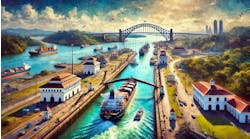The just released 2008 report from the Great Lakes Seaway Ballast Water Working Group (BWWG) finds that 99% of oceangoing vessels bound for Great Lakes Seaway System ports from outside the US or Canada had their ballast tanks examined. This represents significant growth in the program, with 74% receiving inspections in 2007.
The BWWG includes representative agencies of both the US and Canada. The group coordinates enforcement and compliance efforts by both countries. In 2008, one member, the US Department of Transportation’s Saint Lawrence Seaway Development Corporation (SLSDC) implemented regulations requiring all oceangoing ships with no ballast in their tanks to conduct saltwater flushing of their empty ballast water tanks before arriving at the Seaway.
Commenting on the effort, SLSDC Administrator, Collister Johnson, Jr., observed, “The new Seaway regulations, along with those of Transport Canada and the US Coast Guard and best management practices, strengthen environmental oversight of oceangoing ships prior to entering the Seaway.
The BWWG expects continued high compliance rates for ships to continue through 2009. It notes that ballast water management requirements in the Great Lakes and St. Lawrence Seaway System are among the most stringent in the world.


